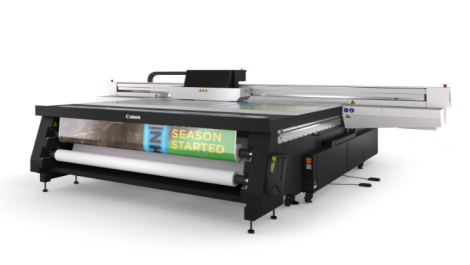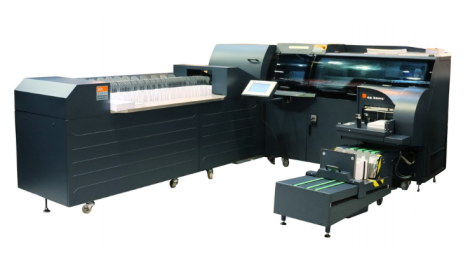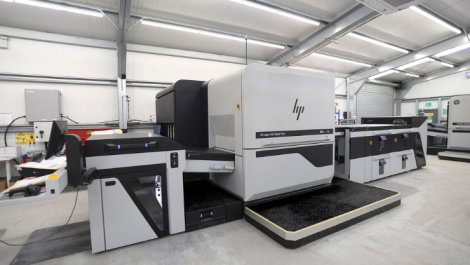Simon Landau, technical consultant for GMG UK, explains how its 4-dimensional colour management gives consistency in mixed process workflows.
Colour management technology for digital printing is maturing, becoming easier and more economical to use, and customers are more aware of the advantages in delivering consistent, accurate colour. More and more printers are now creating hybrid production environments, comprising of digital and offset printing. At the same time, they are building files for electronic delivery, such as web, smartphone, or iPad.
Typically a single print job may be produced by different printing processes – for example, the main body of a magazine might be produced on an offset press but the cover could be personalised on a digital press, while the job is also repurposed for delivery on the web and for reading on tablets.
Print buyers always expect the same colour rendering, regardless of the production method – digital printing, large-format printing, conventional printing processes, or electronic delivery. High colour accuracy, maximum production reliability, and repeatable print quality are increasingly becoming a necessity. Customers also expect rapid production, so it’s desirable to split production over several digital printers or conventional presses. However, device-dependent colour differences can make this difficult.
There are two key components to colour management. One is accuracy – the ability to replicate colours to a standard or the brand and product colours for cosmetics, fashion, etc. The other key is consistency between devices.
One digital press is comparatively easy to colour manage, but multiple presses from different manufacturers are a challenge because the ink/toner characteristics tend to be unique to each manufacturer.
When using multiple processes, such as digital plus a flexo press and/or an offset press, the consistency task becomes insurmountable without the right tools.
Distributed colour management on each front-end results in different colour rendering on the individual printing machines. Manual colour adjustment of data and profiles is a very time consuming procedure, and often fails to produce the required quality. This also requires lots of skill. The operator outputs a proof, goes into the ‘adjust image’ function of a photo editing program, and experiments with the image until the output matches the required colours. Meanwhile, as the operator fixes some colours in the image, something else in the image gets ‘broken’.
When printing with different toners and inks on different machines with different RIPs, centralised colour management is far better than individual printer-based systems. After the system is up and running, all that a printer needs is a spectrophotometer and a measuring process that virtually anyone can follow.
Science replaces skill
A good centralised colour management system supports using a single, standards-based, colour corrected image file that can be safely sent to any printer as a PDF file. This approach also delivers files more ‘forgiving’ to changing conditions. Some colour management systems additionally deliver customised separations optimised to the specific printer, ink and media. This produces more consistency, ink savings, improved drying and better adhesion to the substrate.
The high quality 4-dimensional colour conversions offered by GMG’s own ColorServer optimally convert colours, including spots, to the colour space of the required output devices. The visual colour impression is preserved, regardless of the printing process, press and substrate.
Most colour management systems just balance the primary process colours, ie cyan, yellow and magenta, plus in some cases the greys and other colours often used by inkjets. However, humidity and temperature also affect the ways that devices print. If you linearise in January and then June the results will be different. So we calibrate for colour, not density like the others do.
An ISO Coated V2 appearance can also easily be produced in digital printing, in order to obtain a visual match with offset printing. The ability to match colour between different devices and process allows the device to be selected at the last minute, or a rush job can be split between more than one press for load balancing and greater throughput.
GMG profiling also means that standards, for instance ISO 12647-2:2007, are reproduced within the available colour gamut of the printing system, leading to a dramatic improvement in production reliability and print quality.
Because centralised colour management is based on scientific measurement, it is more reliable. Once installed, anyone can run the system. The incremental costs are for software, an automated spectrophotometer (we recommend X-Rite’s iSiS), a computer to run it on (existing ones will probably be suitable), installation and training.
How it’s done
The workflow is quite simple. The first step shuts off colour management on all RIPs – this isn’t needed because they will now be receiving colour-managed files as input. The RIP is still used to perform printer to media calibration. This involves printing a tone scale for each colour, and adjusting to optimise the match between requested and printed values. Once calibration is complete, the device is linearised.
The final step is creating a reference or ‘fingerprint’ of the printer or press. A reference chart is printed and ‘read’ with a spectrophotometer. This allows the software to understand both what colours your printer can reproduce as well as how it produces them. The software takes the printer colour output, compares it to a preferred standard (GRACoL, for example) and creates a ‘device link’ to correlate the printer’s colour capabilities to the colour standard. Printers with a broader range of colours (ie wider gamut) support a better match to the colour standard or original colour being matched.
A device link profile includes all relevant information for a specific paper, the proofer used and the ink used with the proofer. This profile is linked to a specific printing process with a specific class of paper and can action a perfect CMYK-to-CMYK colour transformation so that the final print can be simulated with contract proof quality on an ink jet printer.
It’s important to realise that GMG does not use ICC profiles. There are many limitations of ICC, for example the handling of the black channel. When using ICC for colour space conversions, the CMYK values of the target colour space are computed in and out of the CIELAB colour space. This means that black generation properties, since it is only a 3-dimensional colour space that doesn’t contain any information about black. Hence GMG’s use of a 4D colour space where the black information is included and can be preserved in conversions.
Under ICC conditions, the CMYK-CIELAB-CMYK conversion can lead to a different proofing or printing result, producing artifacts in vignettes plus ‘non smooth’ effects. The device link approach doesn’t have these problems, as it is a direct CMYK-to-CMYK colour transformation without the detour via LAB. This ensures that the visual impression of the print remains identical, even after colour transformation for a new device.
Also the majority of ICC profile creators are based on an offset colour model, which doesn’t have particularly pure CMY colours. You may see a lot more chromatic hue on digital inks and toners, ie bluer cyan and redder magenta, which can give you a wider colour gamut. If you can’t utilise the digital colours and you have to clip them too much, that has an effect on the overall gamut you can achieve on that device.
We don’t have that issue with GMG software, as we use a true 4-dimensional colour space. Our neutrals are mapped in after the creation of the fingerprint, so we don’t generally have to restrict primaries other than the normal TAC. These don’t apply to digital.
Recalibration
GMG’s recalibration technology and the 4D colour engine is its USP, and why it’s kept going for 30-odd years. Calibration with GMG SmartProfiler ensures optimum reproducibility of the required quality standard and it is easy to recalibrate to get the press back to the ideal, which we term the ‘golden state’ where they can print identically.
So if you were to print on a digital press one day and needed to print identically on that press two or three months later, you are more likely to be able to do it on our technology than anybody else’s because they are restrained to only linearising the primaries. GMG uses 533 colour patches and provides an iterative process whereby the software works out what to do to the CMYK output to bring the device back to exactly where it was when profiling was first done.
Where’s the proof?
Although digital presses can in principle
generate their own proofs by running one or two copies of a job to show to the customer, in practice this can disrupt production, especially if the paper has to be replaced. It may be preferable to use a smaller printer to predict what a job will look. However, when a company cannot achieve accurate, consistent colour between different printers, it can’t rely on a ‘proof’ to represent the final job.
If all of the printers are linked and managed to the same standard, a proof can be printed on any device (such as a smaller Epson or HP printer), and it will be accurate.
Results
With a good centralised colour management solution, users can easily and quickly achieve considerable quality improvements in digital printing, getting the best out of the press. In a few steps, you can match the colour results of your digital press to conventional printing processes such as offset, while at the same time achieving colour stability during the whole run.
Contact: www.gmgcolor.com





